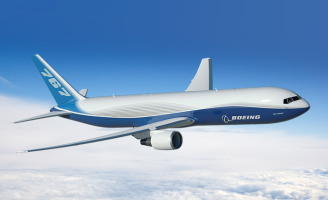Building a large commercial jet is an unbelievable undertaking. While jet orders ebb and flow with the health of the global economy, we believe the long-term demand trajectory is up and to the right, and the jet industry’s competitive dynamics will ensure Boeing (BA) remains a key player in the market for decades to come. For these reasons, BA is a strong stock to consider for our Top 20 Dividend Stocks list.
Business Overview
BA is the world’s largest aerospace company and leading manufacturer of commercial airplanes and defense, space and security systems. The single biggest exporter and the only large commercial jet manufacturer in the United States, BA supports airlines and U.S. and allied government customers in more than 150 countries (non-US customers = 58% of BA’s revenue). Its products include commercial and military aircraft, satellites, weapons, electronic and defense systems, launch systems, advanced information and communication systems, and performance-based logistics and training.
Segments
Commercial Airplanes (66% of revenue, 10.7% operating margin): develops, produces, and markets commercial jet aircraft and provides related support services, principally to the commercial airline industry worldwide. BA’s family of commercial jetliners in production includes the 737 narrow-body model and the 747, 767, 777 and 787 wide-body models.
Defense, Space & Security (34% of revenue, 10.1% operating margin): about 65% of this segment’s revenue is derived from the US Department of Defense. International defense markets account for the majority of the remaining revenue. Products sold include military aircraft and weapons systems (e.g. fighter aircraft and missile systems), electronics and information solutions, strategic missile and defense systems, space and intelligent systems, and global services and support.
Business Analysis
 The large commercial aircraft market (planes with at least 150 seats) is a duopoly, with BA and Airbus (EADSF) each capturing close to 50% of orders (Airbus delivered 629 jets in 2014 compared to BA’s 723). We believe it would take decades for a third meaningful player to emerge given the nature of the large aircraft market. The barriers to entry are just too high.
The large commercial aircraft market (planes with at least 150 seats) is a duopoly, with BA and Airbus (EADSF) each capturing close to 50% of orders (Airbus delivered 629 jets in 2014 compared to BA’s 723). We believe it would take decades for a third meaningful player to emerge given the nature of the large aircraft market. The barriers to entry are just too high.
First, the cost to develop, build, and deliver a new large commercial airplane is tremendous. The Boeing 777 and the Airbus A380 each had development costs in excess of $10 billion, and designing an aircraft generally takes eight to 10 years for a new model and around five years for a variant of an existing model. Development plans are notorious for going over budget and experiencing delays. For example, BA’s 777 was originally budgeted at only $2 billion but ended up costing five times that amount, and Airbus’ A380 went about 40% over its initial budget. Most recently, the 787-8, Boeing’s newest model, was delivered in September 2011, following a more than three-year delay. Given the long time horizon and risk of production delays, financing these massive projects is very difficult.
Due to the high costs and lengthy timeframe required to produce a new aircraft model, it’s not surprising that BA has only designed eight planes from scratch since it started building jets in 1955, and Airbus has only designed four since 1969. New entrants to the market need billions of dollars and potentially decades of time to create a competitive aircraft model.
Many investors don’t realize the level of capital spending and subsidies Airbus and BA required over multiple decades to become the companies they are today. Airbus received around $25 billion in subsidies from three European national governments in its first 20 years of operation to keep it afloat and give it a chance at competing against BA and McDonnell-Douglas (later acquired by BA in 1997). BA lost money over its first twenty years of operations and was only able to strengthen itself as a leader in aerospace because of the high volume of production during World War II (BA was able to develop its first commercial jet airliner because of the technology and knowhow it had developed in the construction of military jets). BA and Airbus also benefit from their massive size today by purchasing materials in bulk on favorable terms. China recently launched a company that plans to build large commercial aircraft and presumably has the financial firepower to subsidize it, but it will likely take many years, if not decades, for it to be competitive and gain trust in the marketplace.
With such massive investment required to commercialize a new airplane and generally hundreds of orders needed to achieve profitability, national and regional markets are too small for a company to turn a profit. In other words, a new entrant would need to be able to take its business globally from day one to be financially viable, creating another barrier to entry.













Leave A Comment